Examining the Relationship between Urban Land Expansion and Economic Linkage Using Coupling Analysis: A Case Study of the Yangtze River Economic Belt, China
Abstract
:1. Introduction
2. Materials and Methods
2.1. Study Area
2.2. Data Source and Data Pre-Processing
2.3. Methods
2.3.1. The Indexes for Evaluation of Urban Land Expansion (ULE) and Economic Linkage
2.3.2. Evaluation of the Economic Linkage
3. Results
3.1. Spatial and Temporal Characteristics of the Urban Land Expansion (ULE) in the Yangtze River Economic Belt (YREB)
3.2. Characteristics of Economic Linkage in the YREB between 1990–2015
3.3. Analysis of the Bivariate Spatial Autocorrelation between ULE and the Economic Linkage in the YREB
3.4. Coupling Coordination Analysis between ULE and Economic Linkage in the YREB
3.4.1. Analysis of Coupling Degree
3.4.2. Types of Coupling Coordination
4. Discussion
4.1. The Implications of Coupling Coordination to Sustainable Urban Land Use in the YREB
4.2. Uncertainties and Future Study
5. Conclusions
Author Contributions
Funding
Acknowledgments
Conflicts of Interest
References
- Nguyen, L.H.; Nghiem, S.V.; Henebry, G.M. Expansion of major urban areas in the US Great Plains from 2000 to 2009 using satellite scatterometer data. Remote Sens. Environ. 2018, 204, 524–533. [Google Scholar] [CrossRef]
- Irwin, E.G.; Bockstael, N.E. The evolution of urban sprawl: Evidence of spatial heterogeneity and increasing land fragmentation. Proc. Natl. Acad. Sci. USA 2007, 104, 20672–20677. [Google Scholar] [CrossRef] [PubMed] [Green Version]
- Seto, K.C.; Golden, J.S.; Alberti, M.; Turner, B.L. Sustainability in an urbanizing planet. Proc. Natl. Acad. Sci. USA 2017, 114, 8935–8938. [Google Scholar] [CrossRef] [PubMed] [Green Version]
- Chuai, X.; Huang, X.; Lu, Q.; Zhang, M.; Zhao, R.; Lu, J. Spatiotemporal Changes of Built-Up Land Expansion and Carbon Emissions Caused by the Chinese Construction Industry. Environ. Sci. Technol. 2015, 49, 13021–13030. [Google Scholar] [CrossRef]
- Yang, Y.; Liu, Y.; Li, Y.; Du, G. Quantifying spatio-temporal patterns of urban expansion in Beijing during 1985–2013 with rural-urban development transformation. Land Use Policy 2018, 74, 220–230. [Google Scholar] [CrossRef]
- Long, H.; Ge, D.; Zhang, Y.; Tu, S.; Qu, Y.; Ma, L. Changing man-land interrelations in China’s farming area under urbanization and its implications for food security. J. Environ. Manag. 2018, 209, 440–451. [Google Scholar] [CrossRef]
- Zhou, Y.; Guo, L.; Liu, Y. Land consolidation boosting poverty alleviation in China: Theory Practice. Land Use Policy. 2019, 82, 339–348. [Google Scholar] [CrossRef]
- Liu, Y.; Song, W.; Deng, X. Understanding the spatiotemporal variation of urban land expansion in oasis cities by integrating remote sensing and multi-dimensional DPSIR-based indicators. Ecol. Indic. 2019, 96, 23–37. [Google Scholar] [CrossRef]
- Long, Y.; Zhai, W.; Shen, Y.; Ye, X. Understanding uneven urban expansion with natural cities using open data. Landsc. Urban Plan. 2018, 177, 281–293. [Google Scholar] [CrossRef] [Green Version]
- Xu, Q.; Zheng, X.; Zhang, C. Quantitative Analysis of the Determinants Influencing Urban Expansion: A Case Study in Beijing, China. Sustainability 2018, 10, 1630. [Google Scholar] [CrossRef] [Green Version]
- Yue, W.; Fan, P.; Wei, Y.D.; Qi, J. Economic development, urban expansion, and sustainable development in Shanghai. Stoch. Environ. Res. Risk Assess. 2012, 28, 783–799. [Google Scholar] [CrossRef]
- Wu, Y.; Dong, S.; Huang, H.; Zhai, J.; Li, Y.; Huang, D. Quantifying urban land expansion dynamics through improved land management institution model: Application in Ningxia-Inner Mongolia, China. Land Use Policy 2018, 78, 386–396. [Google Scholar] [CrossRef]
- Liu, Y.; Fan, P.; Yue, W.; Song, Y. Impacts of land finance on urban sprawl in China: The case of Chongqing. Land Use Policy 2018, 72, 420–432. [Google Scholar] [CrossRef]
- Shu, C.; Xie, H.; Jiang, J.; Chen, Q. Is Urban Land Development Driven by Economic Development or Fiscal Revenue Stimuli in China? Land Use Policy 2018, 77, 107–115. [Google Scholar] [CrossRef]
- Li, H.; Wei, Y.D.; Zhou, Y. Spatiotemporal analysis of land development in transitional China. Habitat Int. 2017, 67, 79–95. [Google Scholar] [CrossRef]
- Wu, K.; Zhang, H. Land use dynamics, built-up land expansion patterns, and driving forces analysis of the fast-growing Hangzhou metropolitan area, eastern China (1978–2008). Appl. Geogr. 2012, 34, 137–145. [Google Scholar] [CrossRef]
- He, C.; Zhang, D.; Huang, Q.; Zhao, Y. Assessing the potential impacts of urban expansion on regional carbon storage by linking the LUSD-urban and InVEST models. Environ. Model. Softw. 2016, 75, 44–58. [Google Scholar] [CrossRef]
- Mustafa, A.; Heppenstall, A.; Omrani, H.; Saadi, I.; Cools, M.; Teller, J. Modelling built-up expansion and densification with multinomial logistic regression, cellular automata and genetic algorithm. Comput. Environ. Urban Syst. 2018, 67, 147–156. [Google Scholar] [CrossRef] [Green Version]
- Vermeiren, K.; Vanmaercke, M.; Beckers, J.; Van Rompaey, A. ASSURE: A model for the simulation of urban expansion and intra-urban social segregation. Int. J. Geogr. Inf. Sci. 2016, 30, 2377–2400. [Google Scholar] [CrossRef]
- Zhao, X.; Zhang, M.; Li, Y.; Huang, X.; Wang, B.; Zhang, L. Urban residential land expansion and agglomeration in China: a spatial analysis approach. Environ. Dev. Sustain. 2019, 87, 1–19. [Google Scholar] [CrossRef]
- Jiao, L.; Liu, J.; Xu, G.; Dong, T.; Gu, Y.; Zhang, B.; Liu, Y.; Liu, X. Proximity Expansion Index: An improved approach to characterize evolution process of urban expansion. Comput. Environ. Urban Syst. 2018, 70, 102–112. [Google Scholar] [CrossRef]
- Zhong, T.Y.; Huang, X.J.; Wang, B.Y. On the degrees of decoupling and re-coupling of economic growth and expansion of construction land in China from 2002 to 2007. J. Nat. Resour. 2010, 25, 18–31. [Google Scholar]
- Braimoh, A.K.; Onishi, T. Spatial determinants of urban land use change in Lagos, Nigeria. Land Use Policy 2007, 24, 502–515. [Google Scholar] [CrossRef]
- Guo, R.; Qian, H.; Zhang, L.; Li, M. Development in the different niche of urban: A case study of Guangdong province. J. Nat. Resour. 2016, 31, 800–811. [Google Scholar]
- Sheng, Y.; Liu, Q.; Ou, M.; Er, L. The Kuznets curve relationship between urban land expansion and economic development across 13 municipalities in Jiangsu. Resour. Sci. 2014, 36, 296–302. [Google Scholar]
- Luo, Q.; Luo, L.; Zhou, Q.; Song, Y.; Luo, Y. Does China’s Yangtze River Economic Belt policy impact on local ecosystem services? Sci. Total Environ. 2019, 676, 231–241. [Google Scholar] [CrossRef]
- Xu, X.; Yang, G.; Tan, Y.; Liu, J.; Hu, H.; Liu, J. Ecosystem services trade-offs and determinants in China’s Yangtze River Economic Belt from 2000 to 2015. Sci. Total Environ. 2018, 634, 1601–1614. [Google Scholar] [CrossRef]
- Cheng, X.; Shao, H.; Li, Y.; Shen, C.; Liang, P. Urban Land Intensive Use Evaluation Study Based on Nighttime Light—A Case Study of the Yangtze River Economic Belt. Sustainability 2019, 11, 675. [Google Scholar] [CrossRef] [Green Version]
- Gao, J.; Wei, Y.D.; Chen, W.; Chen, J. Economic transition and urban land expansion in Provincial China. Habitat Int. 2014, 44, 461–473. [Google Scholar] [CrossRef]
- Morris, S.; Jain, P. Determinants of OFDI: An Empirical Analysis of OECD Source Countries using Gravity model. Indian Econ. Rev. 2015, 50, 243–271. [Google Scholar]
- Persyn, D.; Torfs, W. A gravity equation for commuting with an application to estimating regional border effects in Belgium. J. Econ. Geogr. 2015, 16, 155–175. [Google Scholar] [CrossRef] [Green Version]
- Alonso, M.P.; Beamonte, M.A.; Gargallo, P.; Salvador, M.J. Labour and residential accessibility: a Bayesian analysis based on Poisson gravity models with spatial effects. J. Geogr. Syst. 2014, 16, 409–439. [Google Scholar] [CrossRef]
- Chen, Y. The diatance-decay function of geographical gravity model: power law or exponential law? Chaosolitons Fractals 2015, 77, 174–189. [Google Scholar] [CrossRef] [Green Version]
- Yin, J.; Soliman, A.; Yin, D.; Wang, S. Depicting urban boundaries from a mobility network of spatial interactions: a case study of Great Britain woth geo-located twitter data. Int. J. Geogr. Inf. Sci. 2017, 31, 1293–1313. [Google Scholar] [CrossRef] [Green Version]
- Ye, X.; Wu, L. Analyzing the dynamics of homicide patterns in Chicago: ESDA and spatial panel approaches. Appl. Geogr. 2011, 31, 800–807. [Google Scholar] [CrossRef]
- Rybarczyk, G.; Wu, C. Bicycle facility planning using GIS and multi-criteria decision analysis. Appl. Geogr. 2010, 30, 282–293. [Google Scholar] [CrossRef]
- Wu, C.; Wei, Y.D.; Huang, X.; Chen, B. Economic transition, spatial development and urban land use efficiency in the Yangtze River Delta, China. Habitat Int. 2017, 63, 67–78. [Google Scholar] [CrossRef]
- Monaghan, S.; Lavelle, J.; Gunnigle, P. Mapping networks: Exploring the utility of social network analysis in management research and practice. J. Bus. Res. 2017, 76, 136–144. [Google Scholar] [CrossRef]
- Leon, R.D.; Rodríguez-Rodríguez, R.; Gómez-Gasquet, P.; Mula, J. Social network analysis: A tool for evaluating and predicting future knowledge flows from an insurance organization. Technol. Forecast. Soc. Chang. 2017, 114, 103–118. [Google Scholar] [CrossRef]
- Zheng, X.; Le, Y.; Chan, A.P.; Hu, Y.; Li, Y. Review of the application of social network analysis (SNA) in construction project management research. Int. J. Proj. Manag. 2016, 34, 1214–1225. [Google Scholar] [CrossRef]
- Moran, P.A.P. The Interpretation of Statistical Maps. J. R. Stat. Soc. Ser. B (Methodol.) 1948, 10, 243–251. [Google Scholar] [CrossRef]
- Sun, Y.; Cui, Y. Evaluating the coordinated development of economic, social and environmental benefits of urban public transportation infrastructure: Case study of four Chinese autonomous municipalities. Transp. Policy 2018, 66, 116–126. [Google Scholar] [CrossRef]
- Wang, R.; Cheng, J.; Zhu, Y.; Lu, P. Evaluation on the coupling coordination of resources and environment carrying capacity in Chinese mining economic zones. Resour. Policy 2017, 53, 20–25. [Google Scholar] [CrossRef]
- He, J.; Wang, S.; Liu, Y.; Ma, H.; Liu, Q. Examining the relationship between urbanization and the eco-environment using a coupling analysis: case study of Shanghai, China. Ecol. Indic. 2017, 77, 185–193. [Google Scholar] [CrossRef]
- Salvati, L.; Zambon, I.; Chelli, F.M.; Serra, P. Do spatial patterns of urbanization and land consumption reflect different socioeconomic contexts in Europe? Sci. Total Environ. 2018, 625, 722–730. [Google Scholar] [CrossRef]
- Zheng, Q.; Wang, K.; Huang, L.; Zheng, Q.; Abubakar, G.A. Monitoring the Different Types of Urban Construction Land Expansion (UCLE) in China’s Port City: A Case Study of Ningbo’s Central City. Sustainability 2017, 9, 2374. [Google Scholar] [CrossRef] [Green Version]
- Barbier, E.B.; Burgess, J.C.; Grainger, A. The forest transition: Towards a more comprehensive theoretical framework. Land Use Policy 2010, 27, 98–107. [Google Scholar] [CrossRef]
- Li, Y.; Chen, C.; Wang, Y.; Liu, Y. Urban-rural transformation and farmland conversion in China: The application of the environmental Kuznets Curve. J. Rural. Stud. 2014, 36, 311–317. [Google Scholar] [CrossRef]
- Yaping, W.; Min, Z. Urban spill over vs. local urban sprawl: Entangling land-use regulations in the urban growth of China’s megacities. Land Use Policy 2009, 26, 1031–1045. [Google Scholar] [CrossRef]
- Luo, J.; Wei, Y.D. Modeling spatial variations of urban growth patterns in Chinese cities: The case of Nanjing. Landsc. Urban Plan. 2009, 91, 51–64. [Google Scholar] [CrossRef]
- Lan, F.; Da, H.; Wen, H.; Wang, Y. Spatial Structure Evolution of Urban Agglomerations and Its Driving Factors in Mainland China: From the Monocentric to the Polycentric Dimension. Sustainability 2019, 11, 610. [Google Scholar] [CrossRef] [Green Version]
- Li, H.; Peng, J.; Yanxu, L.; Yi’Na, H. Urbanization impact on landscape patterns in Beijing City, China: A spatial heterogeneity perspective. Ecol. Indic. 2017, 82, 50–60. [Google Scholar] [CrossRef]
- Chiu, R.H. Urban sustainability and the urban forms of China’s leading Mega cities: Beijing, Shanghai, and Guangzhou. Urban. Policy Res. 2015, 30, 359–383. [Google Scholar] [CrossRef]
- Artmann, M.; Inostroza, L.; Fan, P. Urban sprawl, compact urban development and green cities. How much do we know, how much do we agree? Ecol. Indic. 2019, 96, 3–9. [Google Scholar] [CrossRef]
- Chen, H.; Jia, B.; Lau, S. Sustainable urban form for Chinese compact cities: Challenges of a rapid urbanized economy. Habitat Int. 2008, 32, 28–40. [Google Scholar] [CrossRef]
- Hedblom, M.; Andersson, E.; Borgström, S. Flexible land-use and undefined governance: From threats to potentials in peri-urban landscape planning. Land Use Policy 2017, 63, 523–527. [Google Scholar] [CrossRef]
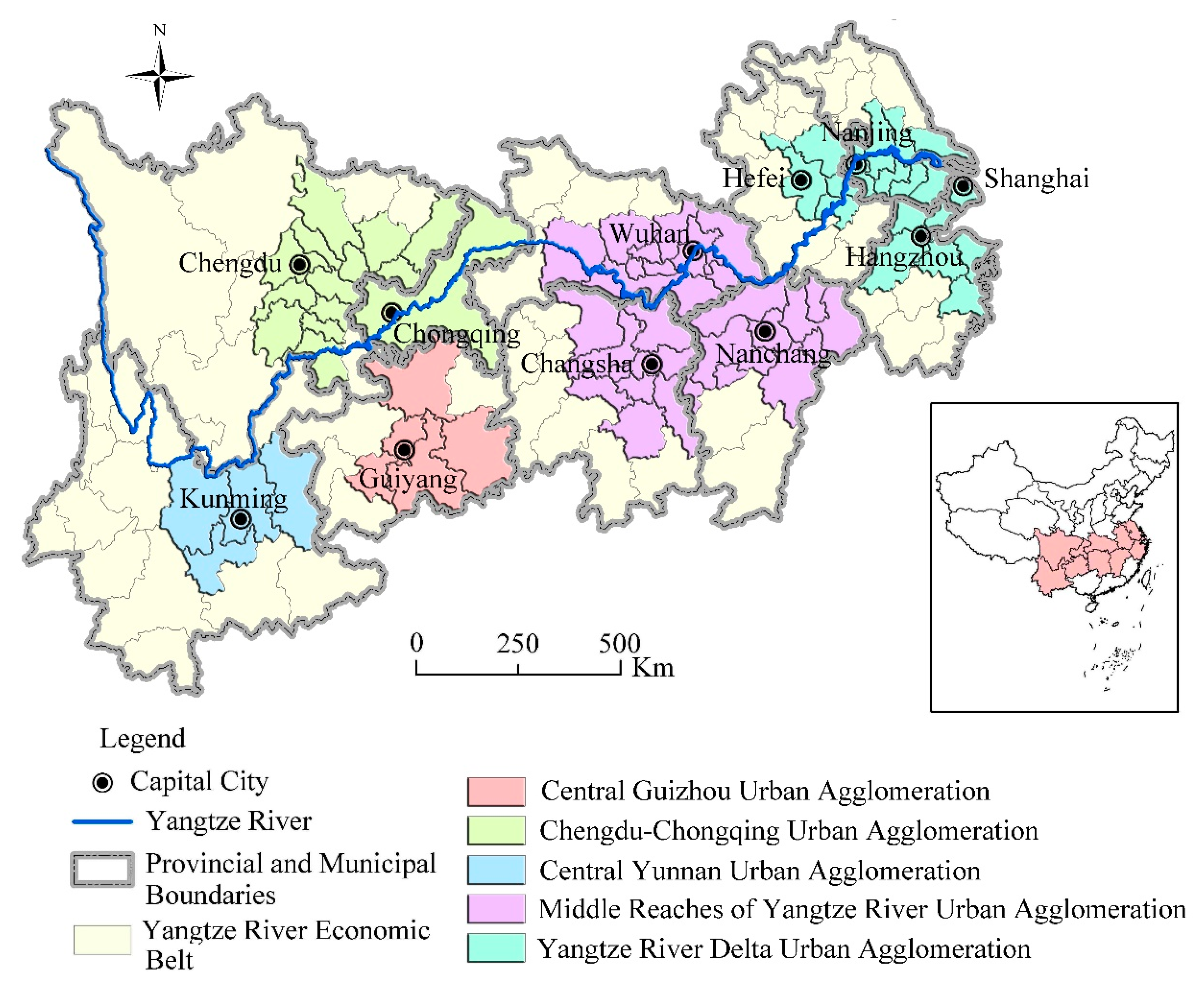
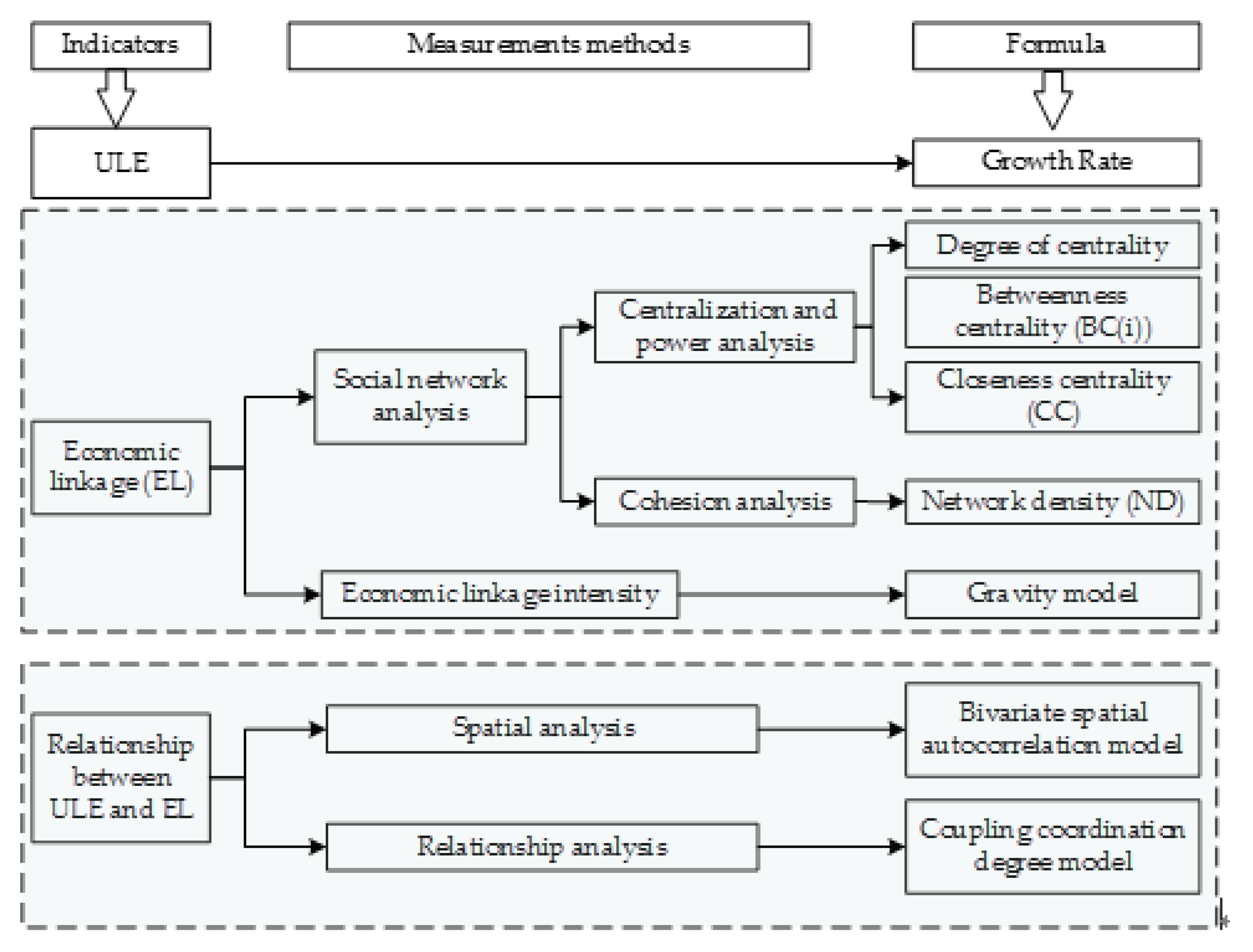


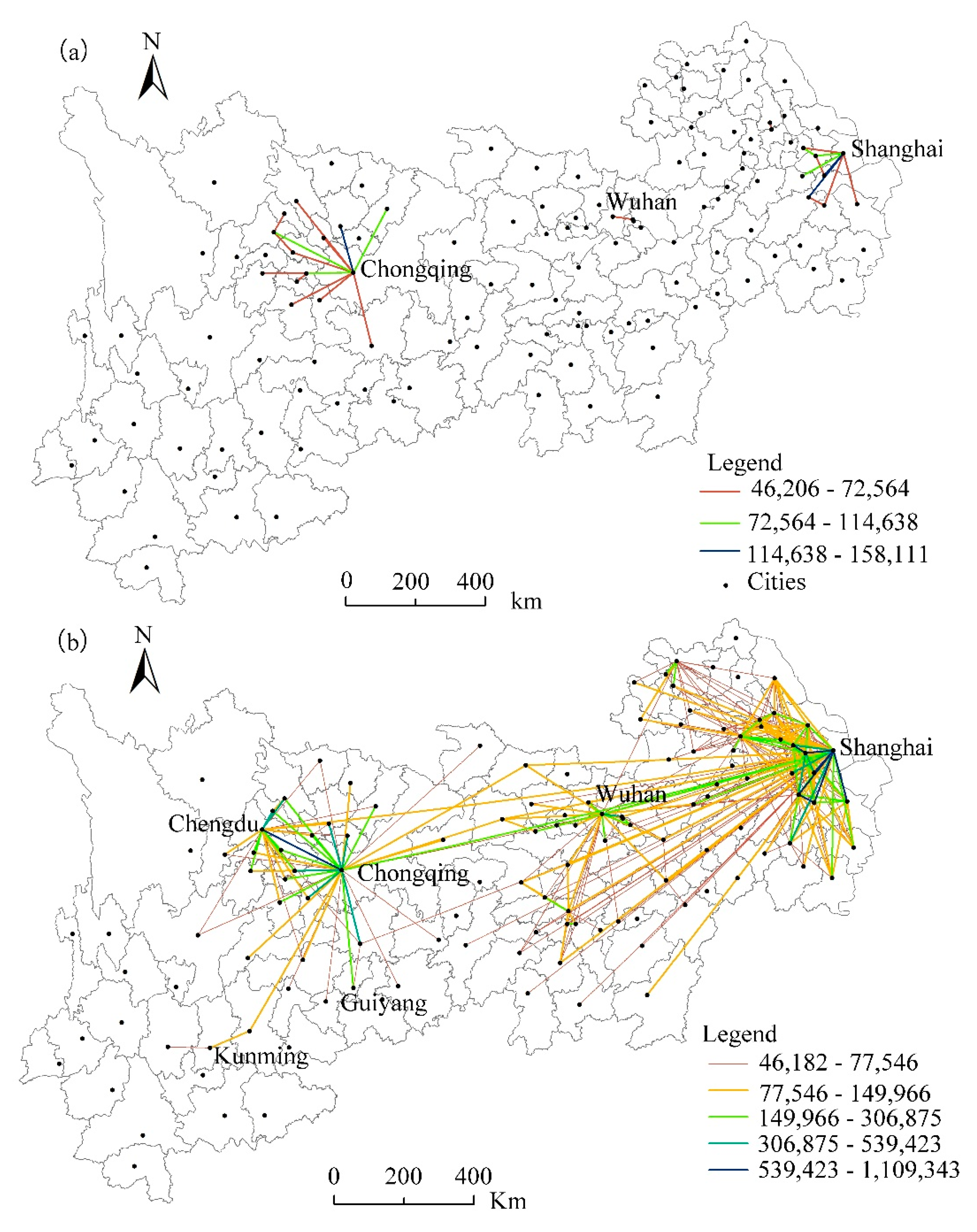

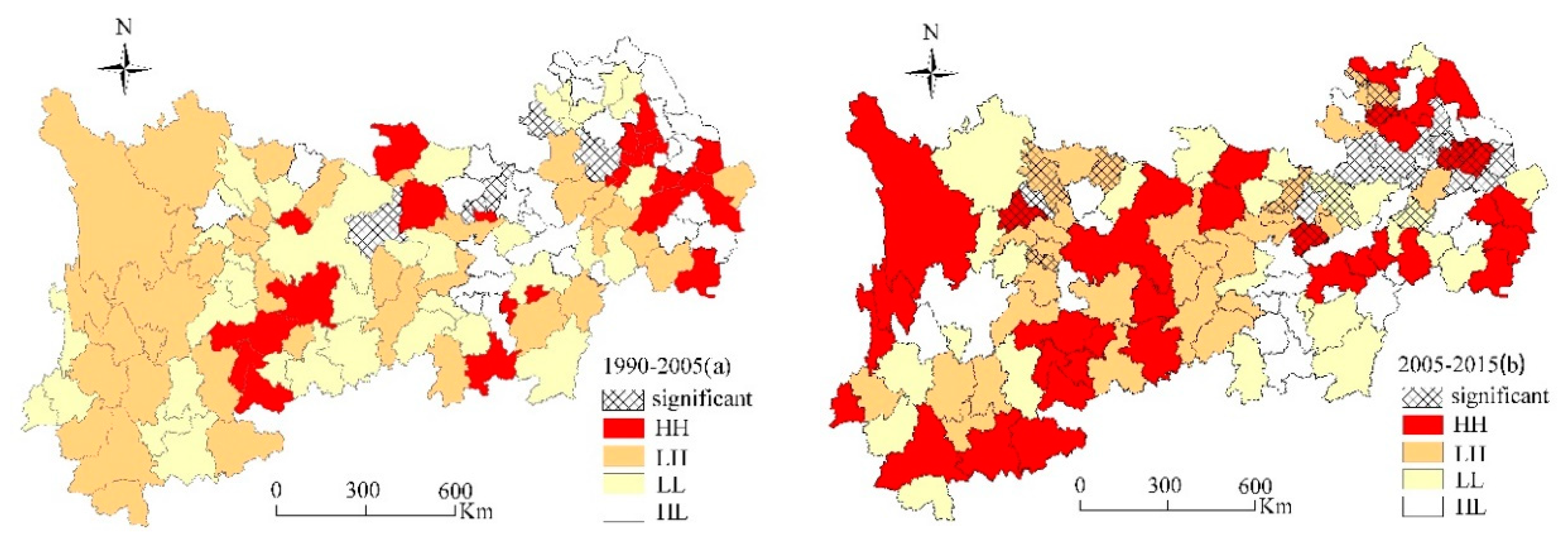
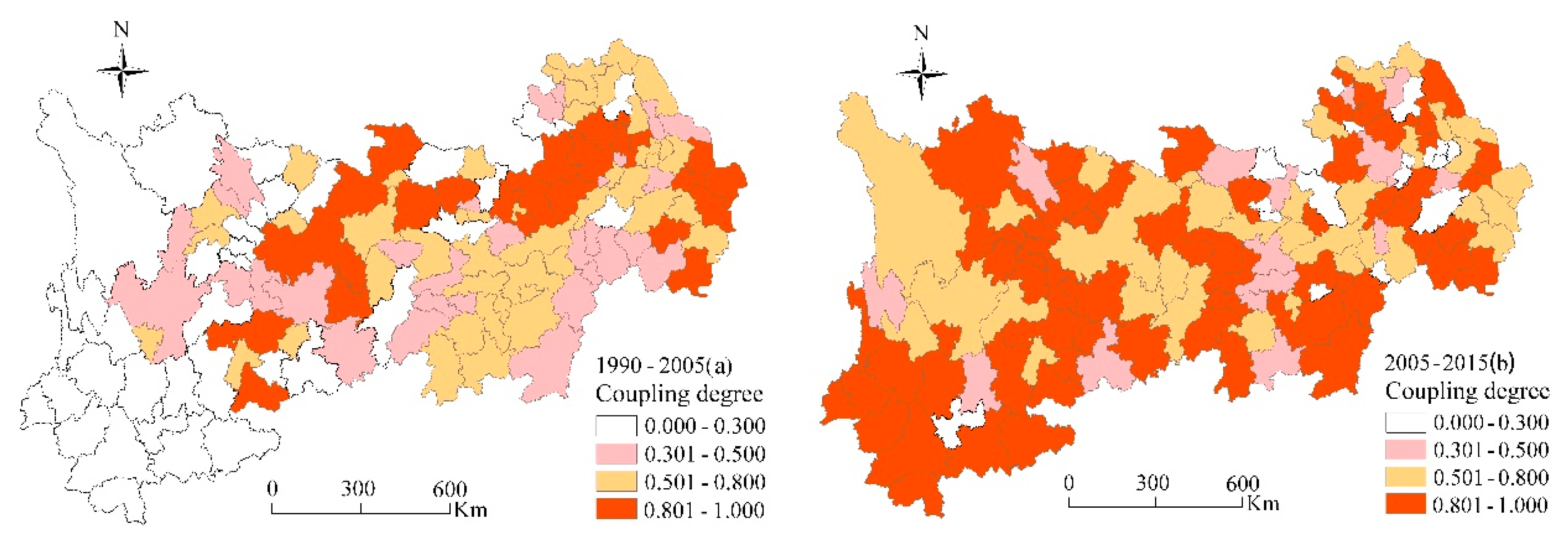
| Index | Calculation | Abbreviation (Code) |
|---|---|---|
| Gross domestic production | -- | GDP (X1) |
| Per capita gross domestic production | GDP/total population | GDPpc (X2) |
| Total population | -- | POP (X3) |
| Rate of secondary industry | Output value of secondary industry/GDP | (X4) |
| Rate of tertiary industry | Output value of tertiary industry | (X5) |
| Per capita fixed asset investment | Fixed asset investment/GDP | FAI (X6) |
| Per capita fiscal revenue | Fiscal revenue/GDP | FR (X7) |
| Total retail sales of social consumer goods | -- | RSSCG (X8) |
| Proportion of non-agricultural population | Non-agricultural population/POP | NAP (X9) |
| Total population of employees | -- | EP (X10) |
| Per capita disposable income of urban residents | -- | DIUR (X11) |
| Primary Classes | Secondary Classes | Types | ||
|---|---|---|---|---|
| Balanced development (acceptable interval) | 0.7 < R < 1.0 (I) | Superior balanced development | G(y)–L(x) > 0.1 (I-A) | Superiorly balanced development with lagging urban land expansion |
| L(x)–G(y) > 0.1 (I-B) | Superiorly balanced development with lagging economic linkage intensity | |||
| 0 < L(x)–G(y) < 0.1 (I-C) | Superiorly balanced development of urban land expansion and economic linkage intensity | |||
| Transitional development (transitional interval) | 0.5 < R < 0.7 (II) | Barely balanced development | G(y)–L(x) > 0.1 (II-A) | Barely balanced development with lagging urban land expansion |
| L(x)–G(y) > 0.1 (II-B) | Barely balanced development with lagging economic linkage intensity | |||
| 0< L(x)–G(y) < 0.1 (II-C) | Barely balanced development of urban land expansion and economic linkage | |||
| Unbalanced development (unacceptable interval) | 0.3 < R < 0.5 (III) | Slightly unbalanced development | G(y)–L(x) > 0.1 (III-A) | Slightly unbalanced development with hindered urban land expansion |
| L(x)–G(y) > 0.1 (III-B) | Slightly unbalanced development with hindered economic linkage intensity | |||
| 0 < L(x)–G(y) < 0.1 (III-C) | Slightly unbalanced development of urban land expansion and economic linkage intensity | |||
| 0 < R < 0.3 (IV) | Seriously unbalanced development | G(y)–L(x) > 0.1 (IV-A) | Seriously unbalanced development with hindered urban land expansion | |
| L(x)–G(y) > 0.1 (IV-B) | Seriously unbalanced development with hindered economic linkage intensity | |||
| 0 < L(x)–G(y) < 0.1 (IV-C) | Seriously unbalanced development of urban land expansion and economic linkage intensity | |||
| 1990–2005 | 2005–2015 | ||||
|---|---|---|---|---|---|
| Prefecture-Level City | GT | Prefecture-Level City | GT | Prefecture-Level City | GT |
| Ningbo | 161.32 | Shaotong | 595.07 | Enshi | 232.06 |
| Suzhou | 149.94 | Shennongjia Forestry District | 543.66 | Suizhou | 223.60 |
| Jinhua | 147.10 | Bijie | 446.32 | Xianggelila | 197.84 |
| Quzhou | 141.53 | Xingyi | 365.14 | Anshun | 192.17 |
| Taizhou | 137.49 | Shiyan | 318.37 | Chongqing | 185.07 |
| Shaoxing | 116.86 | Lushui | 301.37 | Liupanshui | 179.34 |
| Wuxi | 114.16 | Tongren | 285.75 | Lishui | 166.95 |
| Suining | 113.63 | Wenshan | 285.47 | Guangan | 153.92 |
| Lishui | 102.53 | Duyun | 244.79 | Maerkang | 153.57 |
| Wenzhou | 100.74 | Zunyi | 237.76 | Kaili | 150.28 |
| Network Density | Degree Centrality | Closeness Centrality | Betweenness Centrality | |
|---|---|---|---|---|
| 1990 | 0.002 | 0.418 | 0.857 | 0.019 |
| 2005 | 0.035 | 5.217 | 4.177 | 0.621 |
| 2015 | 6.318 | 51.366 | 29.038 | 0.361 |
| Period | Land Category | Moran’s I | p-Value | Z-Value | Standard Deviation |
|---|---|---|---|---|---|
| 1990–2005 | Urban land | −0.058 | 0.018 | –2.138 | 0.027 |
| 2005–2015 | Urban land | –0.03 | 0.151 | –1.035 | 0.029 |
| Periods | Mean Value of Coupling Degree | Low Coupling | Antagonistic Stage | Running-in Stage | Coupling Stage |
|---|---|---|---|---|---|
| 1990–2005 | 0.497 | 38 (29%) | 28 (22%) | 43 (33%) | 21 (16%) |
| 2005–2015 | 0.713 | 15 (12%) | 16 (12%) | 31 (24%) | 68 (52%) |
| YRD Urban Agglomeration | R | Coupling Coordination Level | Middle Reaches Urban Agglomeration | R | Coupling Coordination Level |
|---|---|---|---|---|---|
| Shanghai | 0.77 | (I-C) | Changde | 0.71 | (I-C) |
| Jiaxing | 0.75 | (I-C) | Yichun | 0.75 | (I-C) |
| Zhenjiang | 0.77 | (I-C) | Xianning | 0.57 | (II-B) |
| Suzhou | 0.53 | (II-B) | Zhuzhou | 0.69 | (II-B) |
| Nanjing | 0.50 | (II-B) | Hengyang | 0.62 | (II-B) |
| Ningbo | 0.52 | (II-B) | Fuzhou | 0.60 | (II-B) |
| Yangzhou | 0.63 | (II-B) | Yichang | 0.55 | (II-B) |
| Nantong | 0.52 | (II-B) | Shangrao | 0.61 | (II-B) |
| Taizhou | 0.58 | (II-B) | Jiujiang | 0.52 | (II-B) |
| Chuzhou | 0.56 | (II-C) | Jingmen | 0.61 | (II-C) |
| Shaoxing | 0.49 | (III-B) | Huangshi | 0.55 | (II-C) |
| Hefei | 0.37 | (III-B) | Yiyang | 0.68 | (II-C) |
| Taizhou | 0.45 | (III-B) | Loudi | 0.65 | (II-C) |
| Huzhou | 0.32 | (III-B) | Qianjiang | 0.63 | (II-C) |
| Wuxi | 0.24 | (IV-B) | E’zhou | 0.66 | (II-C) |
| Changzhou | 0.21 | (IV-B) | Wuhan | 0.49 | (III-B) |
| Hangzhou | 0.27 | (IV-B) | Changsha | 0.45 | (III-B) |
| Huainan | 0.02 | (IV-B) | Xiaogan | 0.35 | (III-B) |
| Wuhu | 0.01 | (IV-B) | Nanchang | 0.46 | (III-B) |
| Maanshan | 0.01 | (IV-B) | Yueyang | 0.41 | (III-B) |
| Chengdu-Chongqingurban agglomeration | R | Coupling Coordination Level | Pingxiang | 0.44 | (III-B) |
| Guang’an | 0.70 | (I-B) | Xiangtan | 0.35 | (III-B) |
| Dazhou | 0.70 | (I-B) | Jingzhou | 0.48 | (III-B) |
| Luzhou | 0.71 | (I-B) | Yingtan | 0.22 | (IV-B) |
| Chengdu | 0.60 | (II-A) | Xinyu | 0.24 | (IV-B) |
| Nanchong | 0.65 | (II-B) | Huanggang | 0.05 | (IV-B) |
| Leshan | 0.59 | (II-B) | Xiantao | 0.13 | (IV-B) |
| Chongqing | 0.66 | (II-B) | Tianmen | 0.01 | (IV-B) |
| Yibing | 0.69 | (II-C) | Central Yunan urban agglomeration | R | Coupling Coordination Level |
| Suining | 0.66 | (II-C) | Chuxiong | 0.67 | (II-C) |
| Neijiang | 0.66 | (II-C) | Qujing | 0.65 | (II-C) |
| Meishan | 0.67 | (II-C) | Kunming | 0.31 | (III-B) |
| Ziyang | 0.64 | (II-C) | Yuxi | 0.01 | (IV-C) |
| Zigong | 0.68 | (II-C) | Central Guizhou urban agglomeration | R | Coupling Coordination Level |
| Shaoyang | 0.66 | (II-C) | An’shun | 0.70 | (I-C) |
| Mianyang | 0.35 | (III-B) | Zunyi | 0.73 | (I-C) |
| Qiandong | 0.66 | (II-B) | |||
| Guiyang | 0.65 | (II-B) | |||
| Qian’nan | 0.32 | (III-B) |
© 2020 by the authors. Licensee MDPI, Basel, Switzerland. This article is an open access article distributed under the terms and conditions of the Creative Commons Attribution (CC BY) license (http://creativecommons.org/licenses/by/4.0/).
Share and Cite
Chen, B.; Wu, C.; Huang, X.; Yang, X. Examining the Relationship between Urban Land Expansion and Economic Linkage Using Coupling Analysis: A Case Study of the Yangtze River Economic Belt, China. Sustainability 2020, 12, 1227. https://doi.org/10.3390/su12031227
Chen B, Wu C, Huang X, Yang X. Examining the Relationship between Urban Land Expansion and Economic Linkage Using Coupling Analysis: A Case Study of the Yangtze River Economic Belt, China. Sustainability. 2020; 12(3):1227. https://doi.org/10.3390/su12031227
Chicago/Turabian StyleChen, Bowen, Changyan Wu, Xianjin Huang, and Xuefeng Yang. 2020. "Examining the Relationship between Urban Land Expansion and Economic Linkage Using Coupling Analysis: A Case Study of the Yangtze River Economic Belt, China" Sustainability 12, no. 3: 1227. https://doi.org/10.3390/su12031227
APA StyleChen, B., Wu, C., Huang, X., & Yang, X. (2020). Examining the Relationship between Urban Land Expansion and Economic Linkage Using Coupling Analysis: A Case Study of the Yangtze River Economic Belt, China. Sustainability, 12(3), 1227. https://doi.org/10.3390/su12031227




